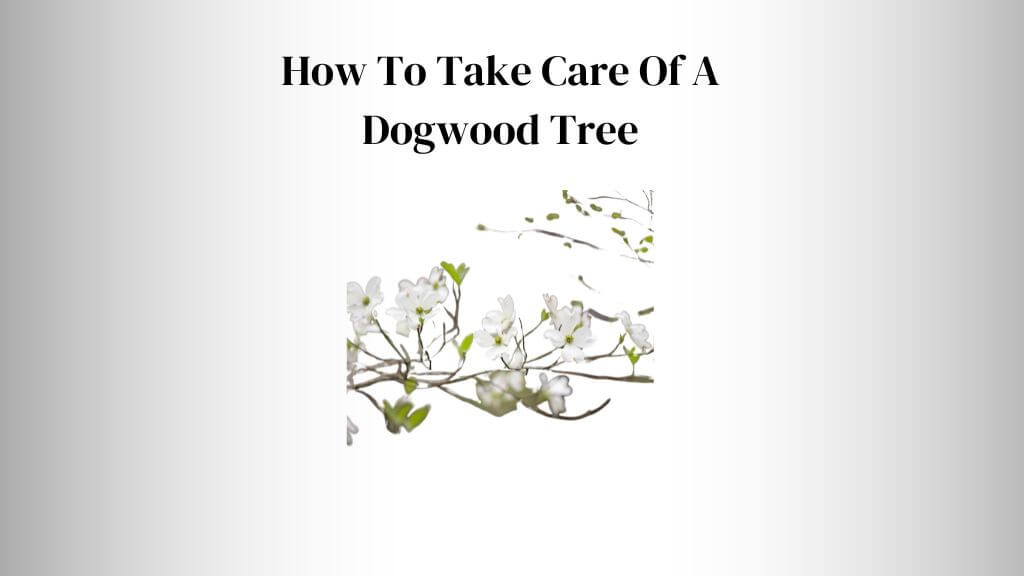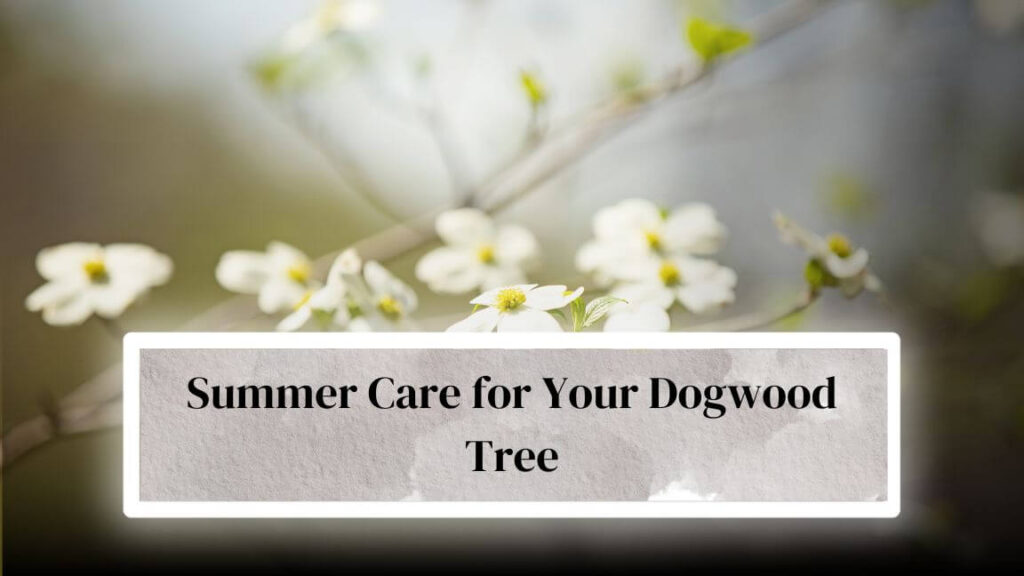
If you want to know how to take care of a dogwood tree, you are in the right place. You must water your tree regularly and properly and fertilize it at the right time. You must also prune your tree during the dormant season and monitor it for signs of infestations or diseases regularly.
Also, protecting your tree from damage, weather events, and climatic changes is equally important. In this article, I will help you learn how to take care of dog food trees in depth and how to keep them healthy. Let’s begin.
How To Take Care Of A Dogwood Tree
Watering Your Dogwood Tree
How Much & When To Water
Since Dogwood trees prefer moist but well-drained soil, please pay attention to it, especially during dry spells. As per the rule of thumb, you should water your trees deeply once a week during the growing season.
But make sure you do this less often in cooler weather or during periods of rainfall. I usually avoid watering during the hottest part of the day as this can cause the water to evaporate too quickly.
If this is the case, the water will not penetrate deeply enough into the soil, causing wilting and yellowing of leaves. It would help if you were watering your dogwood tree early in the morning or late afternoon.
And if the day is very hot, you should mulch around the base of your tree to retain moisture.
Watering Techniques
You should avoid watering your treat leaves or trunk directly. You must provide a slow and steady stream of water directly in the soil around the base of your trees rather than the leaves or trunk.
You can use a soaker hose or drip irrigation system to provide a slow, steady stream of water directly to your dogwood’s roots.
Common Watering Mistakes
One of the most common watering mistakes beginners are more likely to make for dogwood trees is overwatering, which can lead to root rot & other diseases. Another mistake can be underwatering, causing your tree to become stressed and susceptible to pests & diseases.
Fertilizing Your Dogwood Tree
Best Fertilisers For Dogwood Trees
When choosing the right type of fertilizer for your tree, get the one specially formulated for acid-loving trees and plants. I go with a fertilizer with higher nitrogen content, like the 12-4-8 or 10-10-10 formula.
When To Fertilise
It’s important to choose the right type of fertilizer for Dogwood trees and fertilize them at the right time. I like to fertilize all my plants and trees in the spring, just as it begins to produce new growth.
However, you should still provide them with soil amendment during the fall. You can also apply a light dose of fertilizer in the fall to provide nutrients as it prepares for winter.
Application Techniques
You already know that fertilizer should be spread evenly around the tree base. But you should ensure you are not applying fertilizer on the leaves or trunks of your dogwood tree as it may harm it and cause burns. Also, water your tree properly after applying the fertilizer to help it soak into the soil.
Pruning Your Dogwood Tree
Best Time To Prune
As I told you in the introduction section, you must prune your tree at the right time. Do it in the winter, when the dogwood tree is dormant.
It would help if you never pruned your dogwood trees or any other trees during the spring or summer, as this can damage the tree and cause it to produce fewer flowers.
Also Read: How To Prune Red Osier Dogwood
Tools Needed For Pruning
Make sure you are using the right type of tools and equipment. It would help if you used clean and sharp pruning shears or loppers. If you cut larger branches, you might have to use a pruning saw as well.
How To Pruning
- First, make sure you have clean and Shark tools and equipment. Make sure to lubricate all the moving parts as well.
- After getting the right tool, you must wear protective gear like helmets, gloves, goggles, etc.
- Now, inspect your trip properly to remove any dead or diseased branches. Measure, you also take attention and remove all branches crossing or rubbing against each other.
- It would help if you trimmed back any branch that is going too long or seems out of place.
- After you are done pruning your tree, clear all the debris from around your tree to prevent infestations or diseases that might inhibit the other surrounding plants or your three again.
Managing Pests and Diseases
5 Common Pests & Diseases
Some common pests that can affect your dogwood trees are:
- Dogwood borer
- Scale insects
- Japanese beetles
- Aphids
- Spider Mite On Dogwood Trees
Some common Diseases that can affect your dogwood trees are:
- Powdery mildew
- Leaf spot
- Dogwood anthracnose.
5 Signs Of Infestation & Diseases
Some of the common signs of pest infestation on a dogwood tree are:
- Yellowing leaf
- Wilting leaves
- Holes in the bark
- Sawdust-like material at the base of the tree.
- Web-like structure
Some of the common signs of disease on a dogwood tree are:
- Discolored or spotted leaves
- Cankers on the bark
- Twig dieback.
Prevention & Treatment
If you notice any sign of pest infestation or disease, it’s better to consult a professional arborist for proper advice on the best course of action. He may give you a few treatment options like:
- Using chemical pesticides or fungicides,
- Pruning infected branches
- Improving Cultural Practices
To prevent pests and diseases on your dogwood tree, you should first plant it in well-drained soil and make sure it receives adequate water & nutrients. After that, you should avoid anything that may damage the bark or roots of your tree.
Mulching Your Dogwood Tree
You should never ignore this step because Mulching helps retain moisture, regulates the soil temperature, and suppresses weed & grass growth around your tree.
Benefits Of Mulching
- Mulching will conserve moisture in the soil, especially on hot days, reducing the need for frequent watering.
- Mulching also helps regulate soil temperature, which ultimately protects the roots of your tree from extreme heat or cold.
- You should consider mulching if you’re looking for ways to suppress weed or grass growth that reduces competition for nutrients.
- If you want to add organic matter to the soil, Mulching helps you do that. You should know that mulch decomposes, which overall improves soil fertility.
5 Best Mulching Materials
- Shredded bark
- Straw
- Pine needles
- Compost
- Grass Clippings
Note: You should never use mulch made from freshly chipped wood, as it can leach nitrogen from the soil as it decomposes.
Techniques For Mulching
- Firstly, ensure you’re only applying a 2-3 inch layer of mulch around the base of your tree that extends out to the drip line.
- Please keep the mulch a few inches away from your dogwood’s trunk, as it will help in preventing moisture from accumulating and causing rot.
- Experts advise renewing all types of mulch layers every year to maintain a consistent depth.
Supporting Your Dogwood Tree

Lastly, you should properly support your dogwood tree, especially if it’s young, to prevent damage from high winds or heavy snow. Here are a few ways to do that.
Staking
If your tree is young with a weak root system, staking can greatly support it. I prefer using flexible ties to attach my tree to a stake. While doing this, ensure you don’t damage the bark.
Guying
If you want your trees to prevent leaning or falling, consider securing your tree to a post or anchor. Guying method is ideal and best for larger trees that need to be more stable.
Cabling
If you live in a region that experiences heavy ice, your tree branches can break under the weight of snow. It would help if you considered installing cables between the branches to prevent those from breaking.
Winter Care for Your Dogwood Tree
Preparing For Winter
Before winter sets in, I often prepare my dogwood tree by mulching around its base with 2-3 inches of organic matter like compost or shredded bark. You should also follow this method to keep your tree roots insulated from the cold and keep them from drying out.
Winter Watering
Even during winter, you must keep your dogwood tree hydrated. At this time, your tree will not need as much water as it does during the summer, but still, you should water occasionally. This becomes more important If your area experiences dry spells during the winter.
Protecting From Frost Damage
As you know, dogwood trees are susceptible to frost damage during the winter. I usually like to wrap my tree in burlap or frost cloth before the season’s first frost to protect it.
Summer Care for Your Dogwood Tree

Watering During Drought
During drought, it is important to keep your dogwood tree hydrated. A general rule of thumb is to water your tree once a week during dry periods. I suggest you water deeply so the water reaches the tree’s roots.
Protecting From Sunburn
Yes, a few varieties of dogwood trees are also susceptible to sunburn during the summer months. If you want to protect your tree from this damage, you should provide it with some shade during the hottest parts of the day. I often wrap my tree trunk in tree wrap to protect it from the sun.
Conclusion
This article helps you learn everything you need to know on how to take care of a dogwood tree. It would help if you never ignored the tips or techniques mentioned in this article to keep your tree healthy and thriving. I like to follow a proper schedule for all my plants & trees.
If your tree is suffering from any specific condition, it’s best to consult with Arbo reached in this case. If you find this article helpful, then consider sharing it. Your share will help many people learn how to care for a dogwood tree effectively & healthily.
If you want to learn how to keep a dogwood tree healthy for longevity, check out other guides as well. I have shared many other helpful articles on dogwood tree care and management to share with you on this website. See you in the next post, till then take care & goodbye.
